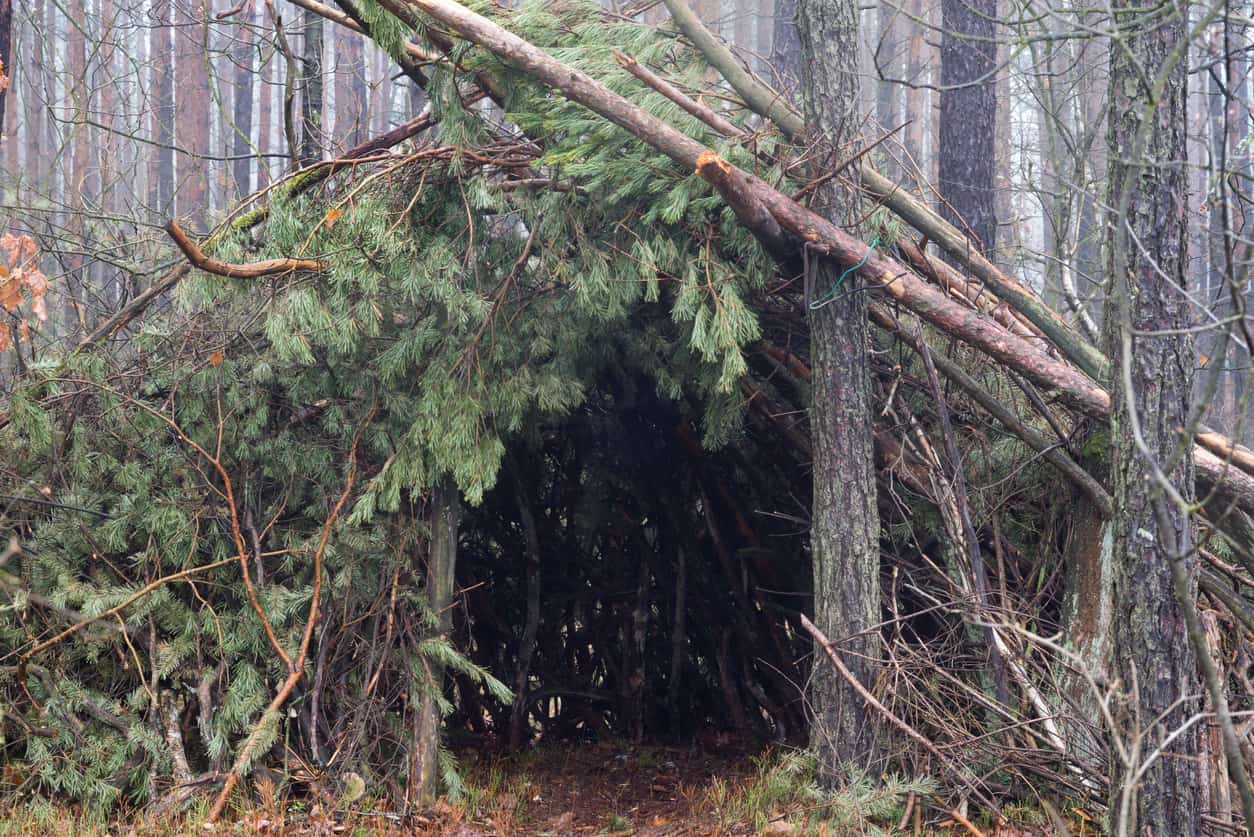
Are you yearning to master the art of building bushcraft survival shelters? This essential wilderness skill provides protection and is crucial for long-term survival.
We will walk you through everything you need to know, from selecting ideal locations and materials to constructing a sturdy shelter that can withstand harsh elements.
Table of Contents
Key Takeaways
- Building bushcraft survival shelters is crucial for protection, safety, and long-term survival in the wilderness.
- Different types of bushcraft survival shelters are explored, including lean-to shelters, debris huts, snow shelters, teepees or wigwams, and bivouacs or tarp shelters.
- Essential skills for mastering bushcraft survival shelters include firecraft techniques, knot tying, and lashings.
The Importance of Building Bushcraft Survival Shelters
Building bushcraft survival shelters is crucial for the following reasons: protection from the elements, ensuring safety and security, and essential for long-term survival in the wilderness.
Protection from the elements
In the wilderness, protection from nature’s diverse elements becomes a priority. A well-built bushcraft survival shelter protects against rain, snow, wind, and extreme heat or cold.
It creates a microclimate that allows for comfortable sleeping, resting, and hiding, essential in challenging outdoor settings. An A-frame shelter design contributes to this life-preserving function by offering two leaning sides for extra support and insulation against severe weather conditions.
Underground shelters are ideal for more severe survival scenarios, such as long-term living outdoors or during harsh climatic conditions, due to their overall endurance and ability to retain warmth effectively.
Safety and Security
Building a solid bushcraft survival shelter provides safety in any wilderness setting. Your structure shields you from potential threats like wild animals, bugs, and other unwanted intruders.
A well-built, robust shelter offers physical security. It imparts psychological comfort by creating an enclosed space that genuinely feels safe.
Safety takes top priority while building your bushcraft campsite. Ensuring the structural integrity of your survival shelter plays a pivotal role in this aspect. Using sturdy materials like hardy branches or logs can strengthen your construction.
Therefore, paying attention to detail when erecting the walls and roof of your bushcraft survival shelter ensures maximum safety and enhances overall security.
Essential for long-term survival
Building bushcraft survival shelters is not just a temporary fix; it’s critical for your long-term survival. The wilderness can be unforgiving; staying alive requires more than finding food or water.
A well-constructed shelter protects you from increasingly harsh environmental conditions and potentially harmful wildlife. It doubles as a warm bushcraft survival shelter during cold nights, helping to prevent hypothermia.
Furthermore, the ability to construct such a sanctuary exemplifies true mastery of bushcraft skills, which could make all the difference between life and death in dire situations. Building an adequate shelter grants you time to strategize, hunt for sustenance, or signal for rescue if necessary.
Step-by-Step Guide to Building a Bushcraft Survival Shelter
Choose a suitable location for your shelter, ensuring it is close to resources such as water and firewood.
Choosing the right location
A good location is essential for building a bushcraft survival shelter. It’s crucial to find an area with the necessary resources and materials for constructing your shelter type of choice.
Evaluating the surroundings is also important, as you want to make sure the location provides adequate protection from harsh weather conditions and offers a sense of security. Additionally, selecting a spot near water sources or natural landmarks can benefit survival.
Site Selection for Avoiding Water Runoff
When selecting the ideal spot to build your survival shelter, it’s crucial to assess the area for signs of potential water runoff or flooding. Even if the weather seems calm and dry when you begin constructing your shelter, conditions can change rapidly in the wilderness.
Take time to carefully examine the surrounding terrain for any indications of past water accumulation or runoff channels. Low-lying areas, gullies, ditches, and dry creek beds are particularly susceptible to flash flooding during heavy rainfall, which could quickly compromise the integrity and safety of your shelter.
To mitigate the risk of water inundation, opt for slightly elevated, flat ground that is not directly in the path of apparent drainage routes. If you must build your shelter on a slope due to limited options, consider digging a small trench around the perimeter to divert water flow away from your site.
Remember, staying dry is paramount to maintaining your core body temperature and preventing hypothermia in a survival situation. By being proactive and strategic about site selection with water runoff in mind, you can greatly enhance the effectiveness and comfort of your shelter, allowing you to focus on other critical aspects of wilderness survival.
Tips for Choosing the Best Location for Your Bushcraft Shelter
Selecting the right spot to build your shelter is just as important as the construction itself. A well-chosen location can provide natural protection from the elements, easier access to resources, and a more comfortable and secure living space. Here are some key factors to consider when scouting for the perfect shelter site:
- Elevation: Look for a spot that is slightly elevated, such as on a small hill or rise. This will help you avoid low-lying areas that may collect water or become damp and chilly at night. An elevated site will also provide better drainage in case of rain and offer a clearer view of your surroundings.
- Natural windbreaks: Take advantage of natural features like large rocks, dense vegetation, or hillsides that can block prevailing winds. Building your shelter on the leeward (downwind) side of these barriers can help reduce wind chill and keep you warmer and more protected.
- Proximity to resources: Choose a location that is close to essential resources like water, firewood, and food sources. Having these necessities nearby will save you time and energy in gathering them and make it easier to maintain your shelter. However, avoid building directly next to water sources, as these areas can be prone to insects and flooding.
- Overhead hazards: Inspect the area above your shelter site for dead branches, loose rocks, or other hazards that could fall and cause injury. These “widow makers” can be especially dangerous in windy conditions or if disturbed by the shelter construction process. Select a spot with a clear and stable overhead canopy.
- Solar exposure: Consider the amount of sunlight your shelter will receive throughout the day. In colder environments, a south-facing location (in the Northern Hemisphere) will maximize solar gain and help keep your shelter warmer. In hot climates, a more shaded spot may be preferable to avoid overheating.
- Flat, stable ground: Look for a relatively flat area with stable soil or ground cover. Avoid building on steep slopes or loose, sandy soil that could shift or collapse under the weight of your shelter. A level foundation will make construction easier and provide a more comfortable sleeping surface.
By taking the time to assess these factors and choose a location that offers natural protection, easy access to resources, and a stable, comfortable living space, you’ll be well on your way to building a successful bushcraft shelter. Remember, the right location can make all the difference in your shelter’s effectiveness and your overall wilderness experience.
Tips for Utilizing Natural Materials in Shelter Construction
Collecting suitable materials is crucial to building a sturdy bushcraft survival shelter. Look for strong and durable branches and logs, as they will form the framework of your shelter.
Additionally, gather long sticks to create walls and a roof. Remember to collect leaves or moss to use as insulation to keep you warm during chilly nights. Remember, the materials you choose should withstand harsh weather conditions and provide adequate protection in the wilderness.
Tip: Check out our list of the best bushcraft knives… a must-have tool for building shelters in the wild.
Here are some tips for making the most of natural materials:
Harvesting and Preparing Bark
Bark from trees like cedar, birch, elm, and poplar can be an excellent waterproof covering for your shelter’s roof and walls. To harvest bark, look for recently fallen trees or standing dead trees, as the bark will be easier to remove. Use a knife or hatchet to cut the bark into manageable sheets, taking care not to damage the inner cambium layer. Overlap the bark pieces on your shelter’s frame like shingles to shed water effectively.
Gathering and Weaving Grasses
Tall grasses, reeds, and cattails can be gathered and woven into thatched panels to create a waterproof roof or walls for your shelter. Harvest the grasses by cutting them near the base, then bundle them tightly and secure them to your shelter’s frame, starting at the bottom and working your way up. Overlap each layer of thatching by about one-third to ensure proper water shedding.
Utilizing Leaves and Pine Needles
Leaves and pine needles can provide excellent insulation for your shelter’s walls, floor, and bedding. Gather large quantities of dry leaves or needles and stuff them into the gaps between the branches of your shelter’s frame. For bedding, create a thick mattress of leaves or needles to insulate you from the cold ground. Be sure to use only dry materials, as damp leaves or needles will compress and lose their insulating properties.
Binding with Cordage
Natural cordage made from plant fibers like nettle, milkweed, or tree bark can be used to securely lash together the components of your shelter’s frame. To make cordage, harvest long, fibrous plant stems and strip away the outer layers to reveal the strong inner fibers. Twist these fibers together tightly to create a sturdy rope that can be used to bind poles and attach covering materials to your shelter’s frame.
By familiarizing yourself with these natural materials and techniques, you can create effective, long-lasting survival shelters using only the resources available in the wilderness around you. Remember to practice these skills in a safe, non-emergency setting to hone your abilities and be prepared for any situation.
Building the frame and foundation
The first crucial step is constructing the frame and foundation to build a bushcraft survival shelter. This provides the structure and stability your shelter needs to withstand harsh conditions.
A solid foundation ensures that your shelter remains level and secure on the ground. Creating a sturdy frame lays the groundwork for adding walls and a roof later on. It’s important to choose durable materials like branches or logs that can support the weight of your shelter.
Focusing on building a robust framework will give you a solid base for creating an effective bushcraft survival shelter in any wilderness situation.
Constructing the walls and roof
To construct the walls and roof of a bushcraft survival shelter, you must utilize the collected materials. Begin by creating a frame using sturdy branches or logs as vertical supports.
Then, gather smaller branches or sticks and weave them horizontally between the vertical supports to create the walls. Consider lashing the branches together with cordage made from natural fibers for added stability.
Once the walls are in place, carefully position large leaves, grasses, or bark over the top to form a watertight roof. Ensure your roof is securely fastened to prevent leaks during rainfall or snowfall.
Adding finishing touches and insulation
Insulation is a crucial element when building a bushcraft survival shelter. It helps to retain body heat and keeps the shelter warm, even in harsh weather conditions. To add insulation, you can fill the shelter’s frame with debris, such as dried leaves or pine branches.
This insulation layer prevents the ground from drawing away heat and protects against cold temperatures. Your bushcraft survival shelter will provide warmth and comfort during your wilderness adventures by paying attention to these finishing touches and insulation techniques.
Different Types of Bushcraft Survival Shelters
This section explores various types of bushcraft survival shelters, including lean-to shelters, debris huts, snow shelters, teepees or wigwams, and bivouacs or tarp shelters.
Lean-to shelters
Lean-to shelters are a common type of bushcraft survival shelter. They are constructed using long pieces of wood and can be covered with debris for insulation. These shelters have one side open, allowing for easy access and ventilation.
One advantage of lean-to shelters is that they can bring fire inside or close to the shelter, providing warmth and cooking capabilities. If you’re looking to build a bushcraft survival shelter, consider lean-to shelters as one of your options.
Debris huts
Debris huts are an incredibly versatile bushcraft survival shelter that can be built in any habitat without needing tools or special equipment. Made from natural materials like leaves, grass, branches, and twigs, they are highly effective airflow management systems.
Not only do debris huts shed water and prevent conduction, but they also provide insulation to keep you warm in harsh weather conditions such as rain, wind, or snow. Learning how to build debris huts is essential for anyone interested in bushcraft and wilderness survival.
Snow shelters
Snow shelters are crucial bushcraft survival shelters that can provide life-saving protection in cold environments. These shelters, such as igloos or snow caves, are specifically designed to withstand the harsh winter conditions and offer excellent insulation against the freezing temperatures.
Utilizing the natural resources available in snowy areas, you can build a sturdy and warm shelter to protect you from hypothermia and other dangers associated with extreme cold.
The guide will provide step-by-step instructions on constructing different types of snow shelters and teach you essential skills for mastering the art of building these necessary structures in survival situations.
Teepees or wigwams
Teepees and wigwams are two types of bushcraft survival shelters that have stood the test of time. Teepees are conical-shaped structures built with wooden poles and covered with animal skins or canvas.
They provide a spacious interior, making them ideal for accommodating larger groups. On the other hand, wigwams are dome-shaped shelters made by constructing curved poles and covering them with bark or hides.
Wigwams offer excellent stability and wind resistance, ensuring durability in harsh conditions. Used by indigenous peoples for centuries, both teepees and wigwams showcase their efficiency as reliable shelter options in the wilderness.
Bivouacs or tarp shelters
Bivouacs or tarp shelters are a versatile and lightweight option for bushcraft survival shelters. These shelters use a large tarp that can be easily folded and carried in a backpack.
The tarp is then set up using poles, trees, or other supports to create a waterproof and windproof shelter. Bivouacs or tarp shelters provide excellent protection from the elements and can be quickly assembled.
They are also highly adaptable, allowing you to adjust their size and shape depending on your needs. With the right skills and knowledge, building a bivouac or tarp shelter can provide a safe and comfortable place to spend the night in the wilderness.
Other Types of Bushcraft Survival Shelters
- A-Frame: Similar to a lean-to, but with a triangular shape that offers more headroom and a larger sheltered area. A-frames can be covered with a tarp, bark, or debris for added insulation.
- Quinzhee: A type of snow shelter that is made by hollowing out a large pile of snow. Quinzhees are labor-intensive to construct but provide excellent protection from cold and wind in winter conditions.
- Wickiup: A dome-shaped shelter made from bent saplings or branches and covered with leaves, grass, or bark. Wickiups are sturdy, waterproof, and can be built in a variety of sizes to accommodate different numbers of people.
- Natural Shelters: In some environments, natural features like caves, rock overhangs, or hollow trees can provide ready-made shelter with minimal modification. These natural shelters can be enhanced with additional materials for added comfort and protection.
Essential Skills for Mastering Bushcraft Survival Shelters
Mastering bushcraft survival shelters requires honing essential skills such as firecraft, knot tying, shelter design principles, understanding natural materials, and adaptability.
Firecraft and primitive fire-making techniques
Firecraft and primitive fire-making techniques are essential skills for mastering bushcraft survival shelters. These skills are crucial for surviving in the wilderness and emergencies.
You can learn these skills by reading How To Start A Fire With Wet Wood, How To Start A Fire Without Matches, How To Build A Campfire, and How To Use A Magnesium Fire Starter.
Knot tying and lashings
Mastering knot tying and lashings is crucial for building bushcraft survival shelters. These skills allow you to secure materials together, creating sturdy structures that withstand the elements.
Knots are essential in every step of shelter building, from constructing frames and foundations to adding finishing touches and insulation. Whether using a tight square lashing or one of the seven survival knots, learning these techniques will enable you to create reliable shelters that provide protection and security in wilderness settings.
So, take the time to practice your knot-tying skills and become proficient in lashings – it’s an investment that will significantly enhance your ability to build effective bushcraft survival shelters.
Essential Knots for Bushcraft Shelter Construction
These knots can be used to secure framework, attach covering materials, and create lashing for added stability. They are some of the most useful knots to master for shelter construction:
- Clove Hitch: A simple, adjustable knot that is used to attach a rope to a pole or tree. Clove hitches are quick to tie and can be easily tightened or loosened as needed. They are often used to secure the ridgepole of an A-frame or lean-to shelter.
- Bowline: A strong, reliable knot that forms a fixed loop at the end of a rope. Bowlines are commonly used to create attachment points for shelter frames or to secure tarps or other coverings.
- Taut-Line Hitch: An adjustable knot that allows you to create tension in a rope without untying it. Taut-line hitches are useful for securing guylines on tarps or other shelters, as they can be easily tightened or loosened to maintain proper tension.
- Square Lashing: A method of joining two poles or sticks at a right angle using a series of wraps and fraps. Square lashings are strong and stable, making them ideal for creating the corners of a shelter frame or attaching crossbeams.
- Diagonal Lashing: Similar to a square lashing, but used to join poles at an angle other than 90 degrees. Diagonal lashings are useful for creating the angled supports of an A-frame or lean-to shelter.
- Shear Lashing: A type of lashing used to join two poles in a parallel manner, creating a stronger and more rigid structure. Shear lashings are often used to reinforce the ridgepole or create a platform for a raised bed.
- Prusik Knot: A sliding knot that grips a rope when weight is applied, but can be easily adjusted when the weight is removed. Prusik knots are useful for creating adjustable guylines or for securing a ridgepole to vertical supports.
By mastering these essential knots, you’ll be able to construct a wide variety of bushcraft shelters with confidence and efficiency. Practice tying these knots in a controlled environment before heading out into the field, so that you can deploy them quickly and effectively when needed. Remember, a well-tied knot can make all the difference in the strength, stability, and comfort of your bushcraft shelter.
Shelter design and construction principles
Mastering the art of building bushcraft survival shelters requires a solid understanding of shelter design and construction principles. By focusing on these fundamental principles, you can create an effective, efficient, and sustainable shelter.
Utilizing natural elements and materials is crucial, as it allows for designs adaptable to different weather conditions while minimizing environmental impact. Whether selecting an appropriate location, collecting suitable materials, or constructing the frame and foundation, learning these principles will equip you with the necessary skills to build a reliable shelter in the wilderness.
Understanding natural materials and their properties
Understanding natural materials and their properties is a crucial skill when it comes to mastering bushcraft survival shelters. Wood, for example, is an essential material for building these shelters due to its durability and availability in the wilderness.
By understanding different types of wood and their properties, such as hardness, flexibility, and rot resistance, you can choose the suitable wood for each shelter component. Furthermore, identifying other natural materials like rocks or leaves that can be used for insulation or waterproofing will significantly enhance your ability to construct a sturdy and weather-resistant shelter.
By acquiring knowledge about natural materials and their properties, you’ll be better equipped to create reliable structures that keep you safe and protected during outdoor adventures.
Adaptability and improvisation skills
Mastering bushcraft survival shelters requires more than just building techniques. Adaptability and improvisation skills are essential for successfully constructing a refuge in unpredictable environments.
These skills allow you to make the most of available resources, creatively problem-solve when materials are limited, and adapt your shelter design to suit specific conditions. Whether using unconventional materials or adjusting your construction plan on the go, being adaptable and skilled at improvisation will significantly enhance your ability to build effective survival shelters in any situation.
So remember, when it comes to mastering bushcraft shelters, flexibility and quick thinking are essential.
Conclusion
“Mastering The Art Of Building Bushcraft Survival Shelters: A Comprehensive Guide” is the ultimate resource for anyone looking to elevate their survival skills and build life-saving shelters in the wilderness.
With step-by-step instructions, a range of shelter types, and tips for mastering backcountry skills, this guide is perfect for outdoor enthusiasts and survivalists. Whether you’re braving harsh weather conditions or simply looking to enjoy nature while honing your bushcraft abilities, this comprehensive handbook has you covered.







Leave a Reply